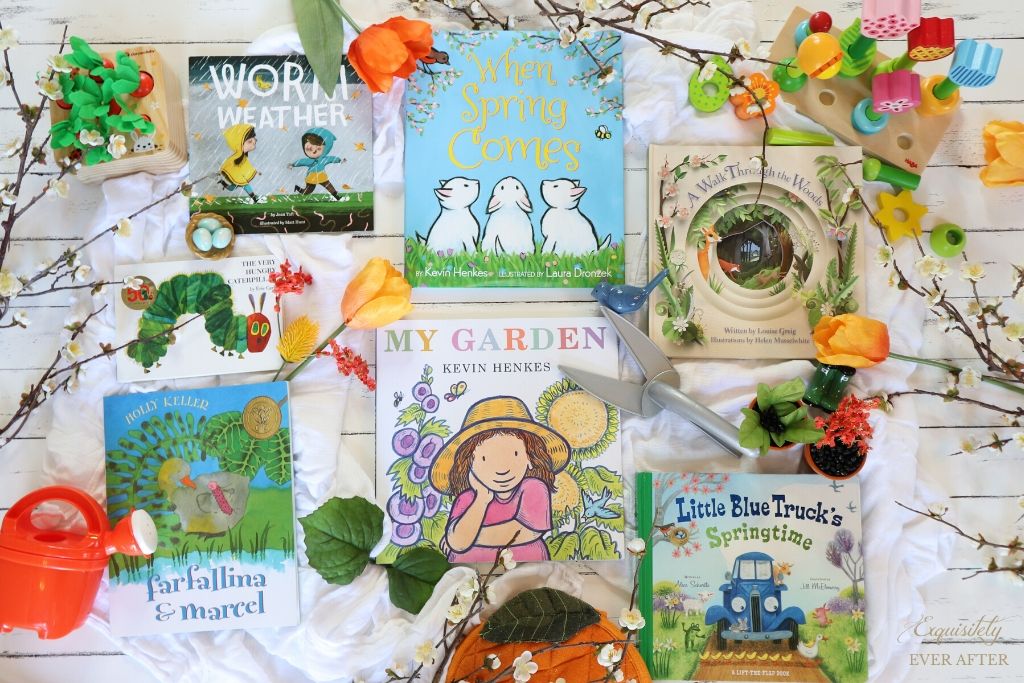
Some links are affiliate links. Please see more here.
SUMMARY: Today’s episode is all about picture books for spring! Since we’re all in isolation, keeping our children engaged, stimulated, and occupied has been a challenge. Reading these springtime books and doing some corresponding spring activities and crafts has been great way to incorporate learning for my preschooler while also involving my toddler without any of us getting overwhelmed. Current brain research tells us that reading aloud to young children is one of the best ways to stimulate language and cognitive skills; to build curiosity, motivation, and memory; and to help our kids grow in empathy. Additionally, these springtime books can give us the inspiration and impetus to get our children to go outside and interact with nature, which positively impacts a child’s development as well as his/her physical and mental health.
I’m always on the lookout for excellent picture books, so please let me know in the comments below: what are your family’s favorite springtime books? And don’t forget to grab your FREE printable weather images PDF if you’d like to do a weather activity with your child (and keep track of the days during this weird, purgatorial period in history)! Take care, keep safe, and keep reading!
Listen to the Podcast Episode:
Books Mentioned In This Episode:
*When Spring Comes by Kevin Henkes, illustrated by Laura Dronzek
Julius the Baby of the World by Kevin Henkes
Owen by Kevin Henkes
Sheila Rae the Brave by Kevin Henkes
Lily’s Purple Plastic Purse by Kevin Henkes
Chrysanthemum by Kevin Henkes
*Farfallina and Marcel by Holly Keller
Romeo and Juliet by William Shakespeare
The Gift of the Magi by O. Henry
*My Garden by Kevin Henkes
*Worm Weather by Jean Taft and illustrated by Matt Hunt
*A Walk Through the Woods by Louise Greig and illustrated by Helen Musselwhite
*The Very Hungry Caterpillar by Eric Carle
*Little Blue Truck’s Springtime by Alice Shertle, illustrated by Jill McElmurry
Little Blue Truck by Alice Shertle, illustrated by Jill McElmurry
Little Blue Truck Leads the Way by Alice Shertle, illustrated by Jill McElmurry
Little Blue Truck’s Halloween by Alice Shertle, illustrated by Jill McElmurry
Note: Books marked with * are the focus books of this episode.
Activities/Crafts Mentioned In This Episode:
When Spring Comes Weather Tracking Activity
Farfallina and Marcel Handprint Butterflies
Rock Painting
“My Garden” Activity
- Gardening Bucket (similar)
- Gardening Tools (similar)
- Wheel Barrow and Gardening Set (similar)
- Sensory Bin Tools
- Pretend Tulips (similar)
HABA Flower Garden Stacking Peg Toy
Wooden Rainbow Stacker Nesting Blocks
Our VEER Cruiser Stroller/Wagon
PODCAST TRANSCRIPT:
Hello Everyone! Welcome to Exquisitely Ever After, a podcast where we talk about reading children’s literature to cultivate kind, intelligent, and successful kids. I’m your host, Christina Phillips-Mattson. I have a Masters and a PhD in children’s and young adult literature from Harvard University and I am a writer, educator, and a mother of two little boys, a three-year-old named James and a one-year-old named Luke.
So today we’re going to talk about picture books that are perfect for springtime. Since we’re all in isolation (and nothing is open anyway), the one thing that we’ve been really grateful for is that the weather is getting warmer and we can spend more time outside. And one positive thing that has come out of being homebound is that this year more than ever we are taking the time to notice and appreciate the change in seasons. In our family, we’ve been doing this by reading books about spring and doing spring-themed activities to go along with our reading. Reading these books and doing these activities has also been great way to incorporate some learning for my preschooler, James, while also involving my toddler, Luke—this is especially important now that we know that school isn’t going to reopen at all this year. Keeping my three-and-a-half-year-old engaged, stimulated, and occupied while also trying to make sure my 15-month-old is engaged, stimulated, and occupied, while also trying to juggle working, managing all the household stuff, and just dealing with life in general under quarantine has definitely been a challenge for me as I’m sure it has been for everyone. But here’s the thing that I keep trying to remind myself of when I start feeling overwhelmed (which is a lot of the time): what our kids really need us to do right now is to help them to feel safe, secure, and loved. And, happily, reading aloud with our children is one of the best ways and one of the easiest ways to do that. When we read aloud, we’re taking the time to really sit with our kids and connect with them and give them the attention and security that they’re craving, especially at a time like this. –And it doesn’t have to be a marathon reading session. Just sitting down and reading one or two picture books a day can help you reassure and reconnect with your child. And, the fact of the matter is, it’s also one of the absolute best “educational” things you can do for your young kids, right now especially but really at any time. Current brain research tells us that reading aloud to young children is one of the best ways to stimulate language and cognitive skills, to build curiosity, motivation, memory, and to help our kids grow in empathy.
So to make it easier on all of us in my household, that’s what I’ve decided to focus on with my children during this time. We read a variety of books at bedtime and quiet time, but I’ve been picking out just a few themed books for each week that I really want to concentrate on and then we read those books together a few times over the course of the week; we talk about the stories and the illustrations, and we do a few simple, fun activities based around those particular books that both my preschooler and my toddler can enjoy. This is giving us some much-needed structure during the week without becoming too stressful or overwhelming for everyone concerned, especially me, because we can take as much or as little time as we want per day to read the books and do the activities, depending on everyone’s schedules (and moods and, you know, level of existential ennui). BUT it also gives me the reassurance that I’m helping my children to continue to grow their brains even during this really weird time in history when we’re cut off from traditional learning. So, these past two weeks, our theme has been “signs of spring” and we’ve been reading books all about spring—spring weather, spring animals, gardens, butterflies, all things spring.—and doing a few springtime activities and crafts based around these books. And before we dive into the books themselves, just a quick reminder that to make it easier so that you don’t have to pause to write everything down, all of the books that I mention, even the ones that I just mention in passing, as well as all of the tools and toys, and any free printables for the activities that go along with the books, all of these things will be linked in the shownotes at exquisitelyeverafter.com/episode2
Okay, so here’s what we’ve been reading:
First up is a picture book written by Kevin Henkes and illustrated by his wife Laura Dronzek called When Spring Comes. Kevin Henkes is the author and illustrator of some of my favorite children’s books, like Julius the Baby of the World, Owen, Sheila Rae the Brave, Lily’s Purple Plastic Purse, Chrysanthemum— the list goes on. He’s incredible and his books really strike the right balance of being informative and engaging to young children, but also having a lot of empathy for them as well as an understanding about what their interests and preoccupations are. When Spring Comes is a very straightforward exploration of the way winter turns into spring for young children, all centered around the theme of waiting patiently for little changes to happen. Trees devoid of leaves grow blossoms and leaves, snowmen melt away, brown grass turns green, eggs become birds, and seeds become flowers if you wait and watch. “You will feel it. You will smell it. You will hear it” the book tells us, emphasizing to the child to use all of his or her senses to observe the changes in the natural world.
Okay, so here’s why this book is great:
First, I like that Henkes and Dronzek show the coming of spring by comparing and contrasting and drawing attention to the minor changes. For example, when Henkes says: “Before Spring comes, the garden is just dirt, and empty. But if you wait, Spring will push green shoots through the dirt to fill up the garden.” Young children are keen observers and they love pointing out differences in color, size, and shape, so this book is perfect for that. As you read, you can ask your child questions about what he sees that is the same and what is different. For example, on this two-page spread where Henkes talks about the garden, ask your child what is the same in each picture and then help him to notice not only the bunny, but the color of the earth and the clay pot. Then ask what’s different and help him to notice the small green plants coming out of the soil, the way the clay pot is now filled with flowers, and the little vegetable markers. This is really simple to do, but it has a really big payoff. It’s important to nurture children’s observation skills at this age because by asking these types of questions, you are actually helping to develop your child’s higher order thinking skills. Answering compare and contrast questions help children focus closely on the details that they hear in the story and see in the illustrations, which improves their reading comprehension skills and also their ability to retain the information that they’re learning. And the knowledge that they gain through comparing and contrasting helps children understand how to organize information, think more clearly, and express ideas more effectively.
So that’s the first thing I really like (comparing and contrasting and paying attention to small changes). The next thing that I think is really great about this book is the way Henkes talks directly to the child reader by using the word “you” and engages her by asking questions like, “Do you like rain?” and “Do you like puddles?” and even joking with her, “I hope you like umbrellas.” It creates an intimacy and helps your child to develop more personal relationship with the book, but it also is helpful in times like these when we want the book to help us get our child actively thinking and responding like she would at school, rather than just passively consuming information. When you read these questions aloud, pause and let your child respond and then ask more questions. You can say, “Do you like puddles? … You do? … Why do you like puddles? … Ah, you like JUMPING in puddles! What sound does it make when you jump? … Splash! Yes! Who else do you know that likes jumping in puddles? … Peppa Pig?! … What does Peppa say about muddy puddles? ‘If you jump in muddy puddles… you must wear your boots!’ That’s right! Let’s sing the jumping up and down in muddy puddles song together…” Conversations like these, even if you’re referencing Peppa Pig, help your child grow his vocabulary, make connections, and enhance his memory.
I also like that when Henkes lists things that go along with spring—like when he says “There will be buds, and bees, and boots, and bubbles” he uses alliteration because this is also a great way that you can incorporate some letter and sound recognition when you read and talk about this book. For example, you can ask your child, “What letter do worm, and wings, and wind, and wheels start with? … Yes! ‘W!’ … Can you think of any other words that start with ‘W’?” Or you could say, “What are some spring words that start with the letter ‘f’?” Or you can use any other letter or go through each letter of the alphabet and spend some time listing those things together. Again, this is another way that the book can do the work for you, which as a parent, I really appreciate.
I also really like the way Henkes emphasizes waiting and the way spring challenges us to be patient. Waiting is so hard for little kids. Just the other day, while I was cleaning up after lunch my son James was watching the “Daniel Tiger” episode where he sings, “it’s very, very, very hard to wait” (other parents of preschoolers, you know the one) and I heard him from the kitchen say, “Huuuh, it IS very hard to wait, Daniel. I’ve been waiting for my popsicle for three hours.” And then heave a huge, dramatic sigh. First of all, he was waiting like 3 minutes and second, I really have to give him credit for unintentionally mastering the subtle art of guilt tripping this early in life. The point is, waiting is something that little kids have to do A LOT and it’s great when a book acknowledges that. I like that Henkes and Dronzek emphasize how spring changes its mind a lot, that one day it will be warm, another day it will snow, and that just when you think you can go outside, it rains for days in a row. It can be so frustrating, but when spring does finally show up for real, your patience is rewarded because there is so much to see and do. This is a really excellent message for children right now, because they are having to practice even more patience than usual while they wait until this quarantine is over to see their friends and family, to go to the playground, to go to school, to do any group activities. We’re all just stuck in this weird purgatory and it’s nice to have a book that reminds us that this won’t be forever and that hopefully all of our waiting will pay off. I mean, I’m not a very patient person either–I pretty much use up all of my patience on my children and then with everything else I’m like, COME ON ALREADY, so I definitely need this message, too.
Finally, I really love the style of the illustrations for this age group of children. The bright acrylic colors are really lush, not the usual pastels that normally show up in spring books for children, and the dark charcoal outlines make it almost look like a coloring book that’s been filled in and smudged a bit. It’s just a very friendly style, which really complements the warm, familiar tone of the text. And this is partly why, although this book is supposedly aimed at 3 to 6-year-olds, you can also make it work for an even younger child. Your toddler can also enjoy this book and have a meaningful learning experience with it if you, for example, concentrate on naming the things you see in the illustrations, like pointing out “bird” or “tree” on each page and repeating those words to help with vocabulary acquisition and animal recognition. OR you could turn it into a seek and find book by asking your toddler questions like, “Can you point to the little bird in this picture?” Or you can use the book as a way to teach animal sounds or colors or counting, like by saying “Look at those little birds in the nest! Their saying “tweet tweet tweet!” “Can you say tweet tweet like the baby birds?” Or “What color is that kitten?” “How many kittens do you see? Let’s count!” In this way, if you have both a toddler and a slightly older child, both can benefit from your reading this book aloud to them. Incidentally, I’m going to do an episode on how you can make almost any picture book work for any age within the range of 0-5 years old, so stay tuned for that in the upcoming weeks. AND, just one more bonus with this book, because much of the text uses short words and sentences, and there’s a lot of repetition, and the story itself is easily decipherable because of the illustrations that go along with it, this is also a good option if you have an early reader in your family, say 5 to 7-year-olds. So, yes, I think this book is a really great choice for right now because if you’re going to order a book, it’s nice if it can be enjoyed by more than one member of your family.
As far as activities that we’ve been doing with this book, we are doing a weather activity right now that was inspired by James’s wonderful preschool teacher where we go outside each day and see what we feel. Is it cold? Is it windy? Is it warm? Is there any rain? Is the sky cloudy or clear? and then we put a little picture of the day’s weather conditions on our calendar with a magnet. We have one of those magnetic white board calendars and I just printed out little images of a cloud, a sun, rain, wind, and, annoyingly, I had to print out a picture of a cloud with snowflakes because apparently even the earth is having a hard time figuring out what’s going on right now and it flurried last week. And side note, this activity has actually been really good for me because frankly every day seems to be blending into the next so tracking the weather each day is giving me some sense of time. I’ll put a link in the shownotes to the PDF I made with the little weather images in case you want to do this activity with your kids. Just go to exquisitelyeverafter.com/episode2 and you can click on the link for the free printable.
Okay, next up is a book called Farfallina and Marcel by Holly Keller. Here’s the plot: A caterpillar named Farfallina and a gosling named Marcel have a kind of meet-cute where Farfallina accidentally eats the leaf that Marcel is huddled under to stay dry in the spring rain. They become fast friends, playing hide and seek and exploring the pond together, Farfallina perching on Marcel’s back. One day Farfallina feels a little uncomfortable, so she climbs up the tree and Marcel waits for her underneath it. But Farfallina doesn’t come back because, unbeknownst to Marcel, she’s actually in chrysalis. Marcel returns to the tree each day to try to find his friend, but time passes and she still doesn’t return and he’s really lonely. Meanwhile, Marcel also notices himself changing when he looks at his reflection in the pond. Weeks later, Farfallina finally comes out of her chrysalis and goes to look for Marcel, but she can’t find him. She goes to the pond every day to look for him, but all she sees there is a fully-grown goose gliding around the water. One day the goose stops and asks Farfallina if she wants to go for a ride since she is always visiting the pond. She agrees and then tells the goose about her friend that she lost and he tells her that he also had a friend who vanished and finally they realize that they are Farfallina and Marcel, and that they each have found their long-lost friend. They are both overjoyed and spend the rest of the spring and summer together and when fall comes, they fly south together.
Okay, here’s why I think this book is a good choice to read this spring:
First off, most obviously for this period of isolation in which we’re all staying home, I like the idea of a book about two friends who are separated for awhile, but whose friendship persists and outlasts the time that they’re apart. This message of enduring friendship is really comforting to small children, especially now when they haven’t seen their friends for over a month and likely won’t see them for quite some time yet. Ugh. It makes me sad just thinking about it. But that’s why this book is really helpful. Children grow and change so quickly, so it’s nice for them to be reassured that no matter how much time has passed and how much they’ve grown and changed, their friends will still love them and be so excited to see them. When Farfallina and Marcel meet again, they are so overjoyed to be reunited and the time apart had no impact on their friendship except to make them even more happy to be together. So this book is a good way to talk to small children about being separated from their friends. AND it’s a good resource to revisit if your child expresses any worry about their friends forgetting about them or not wanting to be friends any more after being apart. These fears might not occur to us as adults because we have FaceTime and social media and things like zoom to keep us connected with our family, coworkers, and friends and, furthermore, physical distance doesn’t matter as much to our friendships because in adulthood, our friendships are based on mutual consideration and psychological satisfaction. But small children and preschoolers are used to associating friendship with play and having fun, happy experiences with other people, and by default that requires more physical proximity. A friend to a young child is mostly a playmate who lives nearby or who is in their same class. So this book is helpful in explaining to your child that friendships are more than that and you can use Farfallina and Marcel’s behavior toward each other as a model of what friendship is and how that means it can outlast any distance or time apart.
And just one more word about their friendship: I particularly like that Farfallina and Marcel, right from the very beginning, are considerate of each other and think about the other’s limitations when they play. For example, when they play hide and seek, Farfallina hides close to the ground because she knows Marcel can’t climb and Marcel hides very near to Farfallina because he knows she can’t move quickly. This friendship model has also been really great for my family right now that my children are each other’s only playmates and their age difference can make some activities frustrating, especially for my three-and-a-half-year-old. Because my 15-month-old can’t do all the things that my preschooler can do, this book helps me remind my older child to take into consideration his brother’s limitations when they’re playing together.
Okay, so the next thing I like about this book is that it’s a nice narrative-based story about the way animals and other creatures grow up. There are plenty of great nonfiction children’s books that show the life cycles of animals, but I like that this is a story where you’re invested in the characters. This is another way you can add in some vocabulary and learning by asking questions like, “Do you know the name of a baby goose like Marcel? He’s a…gosling! A baby goose is called a gosling!” “What are some other baby animals that we see in the spring?” “What is a baby chicken called?” “What about a baby sheep?” And so on… And you can also talk about the whole life cycle of a butterfly if you want to go into more detail about what changes Farfallina is going through.
And finally, I like that this book is a gentle introduction to dramatic irony as a literary technique. Dramatic irony occurs when a character’s words or actions are clear to the reader, but unknown to the character. So the reader knows that the goose on the pond is actually Marcel, the bird that Farfallina is looking for, but Farfallina doesn’t know this. This creates suspense, but even on the first reading, the stakes in this situation aren’t as high as in, say, Romeo and Juliet or even like The Gift of the Magi situation, so your child can enjoy the story without too much worry whether or not the two friends will recognize each other and be reunited. And, also, by the way, the dramatic irony of Farfallina and Marcel can also make it humorous, especially if your child is on his second or third or tenth reading of the story. Young children love to be in on the joke. This is how it went for us; during our first reading, my son James was initially anxiously caught up in the drama of will they- won’t they recognize each other until his ultimate relief when they finally did. Then, during our next reading he thought it was so funny that Farfallina and Marcel didn’t realize the other’s identity and was even more delighted by the conclusion the second time around. But what I like is that, first, by employing dramatic irony, Holly Keller makes the story less predictable and keeps children guessing as to what is going to happen; and second, it’s great when a book for young children foreshadows literary techniques that they will learn in more depth later in their education. It opens up more possibilities for them of how stories can operate and when they start making up their own stories, it gives them more creative options. So it’s great when this happens early on in your child’s reading life.
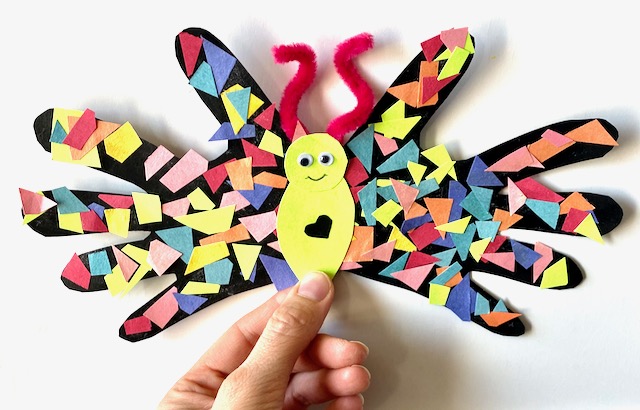
So that’s Farfallina and Marcel. The activity that we did with this book was a craft where we made handprint butterflies. It’s super easy to do. Basically, you take a piece of paper and fold it in half. Then you trace your child’s hand, making sure that the bottom of their hand, where it connects to the wrist, is on the seam of the folded paper. Then, depending on the age and ability of your child, either you or your child cut out the traced handprint, being careful not to cut the seam. Then you unfold the seam and you have the outline of your butterfly. Then what we did was paint the butterfly wings and you can either draw the body or cut it out of paper and glue it on (which is what we did), or you can use a plastic spoon and paste it in the middle. We used pipe cleaners for the antennae and I had some tiny googly eyes left over from another craft and, in the end, they turned out really cute. I’ve also seen a craft where you can use pipe cleaners, a clothespin, and coffee filters to make a butterfly, but we didn’t have coffee filters on hand so we stuck with the handprint.
Our third book is actually another book by Kevin Henkes called My Garden. I hesitated to put another book by the same author in this episode, but this book is just so great and so perfect for spring and there are so many things you can do along with it that I had to put it in. Also, it’s another book that works for multiple age groups—my son James loved this book last spring when he was two and a half, but he’s even more into it now that he’s three and a half, and Luke is also enjoying it at 15 months old—so that’s also definitely another mark in its favor right now.
My Garden is both about actual gardening and also about imaginative gardening. The book begins with the little girl in the story telling us that she is her mother’s helper in the garden; that she waters, weeds, and chases away the rabbits. But then, though she likes her mother’s garden, she begins to imagine what her garden would be like if she had one of her own. And throughout the rest of the book, she describes her imaginary and imaginative garden, where there are no weeds, no carrots (because she doesn’t like carrots), the rabbits are made out of chocolate, tomatoes are the size of beach balls, the flowers can change their colors and patterns at her whim, things like buttons and keys and umbrellas just pop up at random, and if she planted seashells, she would grow seashells. The book ends back in reality, with the little girl taking a seashell from her shelf and poking it into the dirt of the garden, remarking “who knows what might happen?” And when her mother asks her what she’s doing, she replies, “Oh, nothing, just working in the garden.” And the last page is a cross-section illustration of a seashell in the earth, growing roots.
What I like about this book is that it really wholeheartedly indulges a young child’s imagination. Henkes walks us through all the things that you would find in a real garden, but then eliminates any limits by allowing the little girl to imagine her garden in whatever way she wants. A jelly bean bush? No problem! Plaid flowers? Of course! Strawberry lanterns? Obviously! Even the whole thing about there not being any rabbits to eat the lettuce except chocolate rabbits that she can just munch on whenever she wants—which, by the way made me a little uncomfortable as an adult. I’m like, are these anthropomorphic chocolate rabbits that you have to catch to eat? Isn’t that a little bloodthirsty? Or I guess the rabbits’ blood would be, what? chocolate syrup? So chocolate syrup thirsty? Ew. I’ve taken this too far. But you see what I mean—This whole bunny-eating thing is, for a child, just a completely natural extension of this imaginative play. And that’s why I think this book is so appealing to young children, especially preschoolers who still exist in that stage where the real and the imaginary tend to blend together. This is the age where they know that some things are “impossible,” but they still have that “but what if?” mentality about them, just like the little girl who is planting the seashell. She knows it won’t grow a seashell plant, but that doesn’t stop her from planting it anyway, just in case. Preschoolers, kindergarteners, this age group can really see themselves in this character. And it helps, too, that we don’t know the little girl’s name or really anything else about her. She almost just acts as vehicle or entry point for the child reader to start imagining his or her own imaginary garden.
Another thing I like about this book is that even though it ventures into the fanciful, it still reminds us to appreciate nature at its most basic. The illustrations really celebrate the riot of color that happens in a garden in spring and Henkes draws so many varieties of vegetables and flowers and birds in the garden. And the way he draws the little girl really captures her complete absorption and joy of working and playing in the garden. Many of the illustrations show just the back of her head or her hat looking down at the garden and when he draws her face, it’s most often with her eyes closed as if she is savoring the moment, or squinting in the sun, or crinkled in a smile. Every image brings our attention to the way the little girl is completely fascinated by the garden and engrossed in her work.
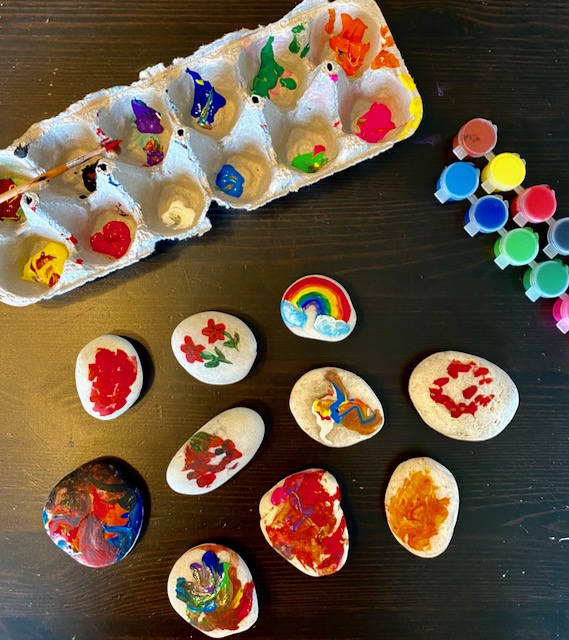
Finally, there are a lot of activities you can do with this book while in isolation. First, you can simply have your child draw a picture of a garden where they can grow whatever they want. My older child did this activity with his preschool class and he had so much fun just imagining the possibilities. Or, if you want to make it more involved (i.e., take up more time), you can have them make their own garden book with a different “plant” on each page. Or, another idea, for some reason my son James is really into having a rock collection right now—I blame Prince Tuesday from “Daniel Tiger’s Neighborhood,” although I remember having a rock collection as a child, too, so maybe it’s just a thing that all kids do. Did you or does your child have a rock collection? DM me and let me know—but, in any case, we have this little bucket of rocks in our garage so we decided to paint pictures of things that we’d want in our garden on the rocks and we “planted” them in a little flower pot on the back porch. Because he is so into rocks at the moment, he also got a rock painting kit in his Easter basket from my parents, so if you live in the city and you don’t have access to rocks, you can get one of these kits and plant the rocks in a flower pot on your window sill (or really, I guess you can put the pot anywhere you want because it’s not like those rocks really need sunlight). James was really into this activity and he painted a rainbow on one rock, a family of red flowers on another one, a Hershey kiss bush, a red beet because he and Luke love to eat beets, and an astronaut—super random, but he had a blast. Obviously, if you have an actual garden, this is the perfect time to involve your child in gardening and if you want to incorporate the book, you could let them have a little plot of the garden to plant whatever they want and then you can check on it every day. It’s amazing how fascinated kids are with checking on the progress of things and how it doesn’t seem to matter to them if nothing has happened.
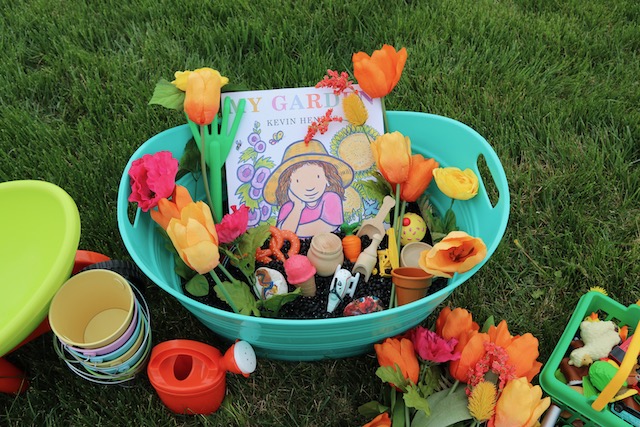
The last project we did to go along with this book is a little more involved set-up-wise, but it’s definitely the one that my kids enjoyed the most and that they spent the most time playing independently—like, I’m talking over 90 minutes—without my having to really interfere or referee, which is always a plus. So, anyway, in lieu of planting an actual garden we planted a pretend garden using fake flowers, dried black beans as the soil, and, in the spirit of this book, whatever else my children fancied which turned out to be toy trains, stuffed animals, little fisher price people and animals, and fake play food.
What you do is you get a big container (you can use a storage container or what I have is a large oval-shaped bucket, like the ones you can use as an ice bucket for drinks at outdoor parties—ah, outdoor parties—mine is plastic because I bought it specifically for my kids to use, but you can use a galvanized metal one, too, and your kids might like the sound the beans make when they pour them in) and you fill it with either uncooked rice, or dried beans, or dried lentils, or you could even do this with sand, although then it gets significantly messier. Then, you take fake flowers, pretend fruit and vegetables, shells, little cars or trains, little plastic or wooden animals, really whatever you have that your child wants to grow in the garden and then you spread everything out and let your child “plant” them in the bucket. We also used little metal flower pots so that we could make “potted plants” or “potted trains” or “potted rocks” or whatever. We used some pretend play gardening tools and these little sensory bin tools and scoops to plant the objects, but you can also just use cups of various sizes or old Tupperware containers and some wooden spoons or ladles, again, really whatever you have lying around that is safe and you don’t mind your child playing with. I actually bought all of the gardening stuff for this activity last year because this is our second spring doing this, but I will put links in the shownotes to all of it if you want to recreate our setup. The only thing I didn’t save was the rice that I used as the “soil” so this year I used dried black beans. And while I’m on the subject of the soil, just one FYI: This activity is best for kids who are past the stage where they put everything in their mouths. I did this with my preschooler and my toddler, but even though they played independently, I did have to watch the little one like a hawk to make sure he didn’t swallow any of the beans. It was worth it because he loved it and it was an awesome sensory activity for him, but if you do try this with toddlers, just, you know, follow Mad Eye Moody’s advice: “CONSTANT VIGILANCE.”
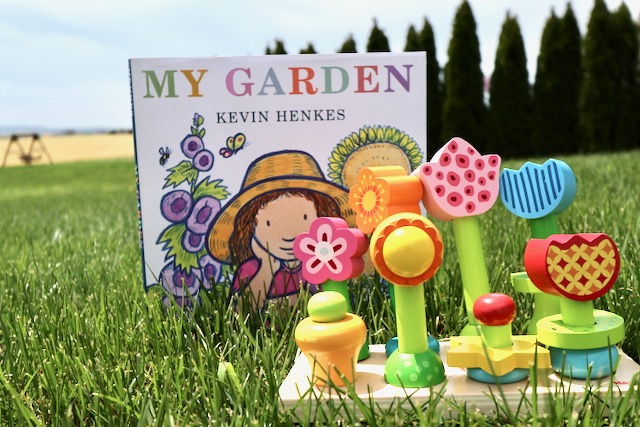
If this still makes you nervous and you want to do a different gardening activity with your little one while your older one does this activity, I can also recommend this little carrot shape-sorting puzzle as well as this other little mix and match flower garden stacking and peg toy from a company called HABA that we really like and Luke has played with a lot these past few weeks. It has little painted wooden dowels that are the stems and then little painted wooden tulips and daisies and leaves and bulbs that your child can mix and match to create a little flower garden. It’s great for hand-eye coordination, developing dexterity, and strengthening motor skills as well as learning the different parts of a flower. This is obviously not sponsored by HABA or anything, but I really like their stuff. It’s super cute, high-quality, and durable. Luke really enjoys stacking all the flower parts and it really keeps him occupied for awhile, so I can do other activities with James—like, for example, we did the entire handprint butterflies craft from start to finish while Luke played with his garden. It’s great for the highchair, too, because it doesn’t require a huge amount of surface area, so I find it a great way to keep Luke occupied while I cook or clean up or even do some work. Anyway, I digress, but I’ll link to it in the shownotes as well in case you think your little one might like it, too.
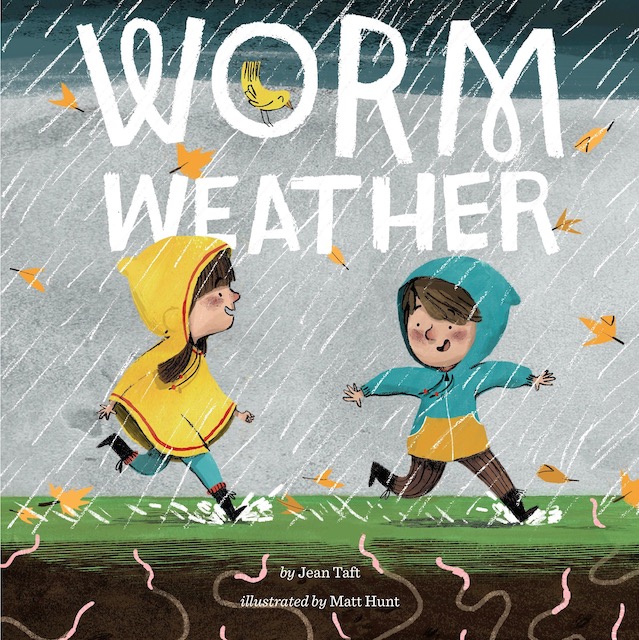
Okay, the last two books that think are great for this spring I want to talk about together because both are more poetry than story. The first one, Worm Weather written by Jean Taft and illustrated by Matt Hunt is for younger children, I’d say up to 4 years old. And the second one, A Walk Through the Woods, written by Louise Greig and illustrated by Helen Musselwhite, is for slightly older children, I’d say age 5 and up.
So first let’s briefly talk about Worm Weather. What I like about this book is that, first of all, it’s a really nice introduction to poetry for young children because it isn’t too abstract. It’s about real, tangible things that they can observe and interact with during the spring, like puddles, rain, and of course, worms. I also like that it celebrates the rain itself rather than views it as a necessary evil or annoyance that we have to deal with in order to get flowers. Instead, it relishes the fun children can have if they take a walk in the rain or after the rain. And I like that it goes through the whole experience: getting ready for a rain walk by putting on raincoats, hats, boots; then running around “boots jump, old tree stump, big stomp, puddle swamp”; then watching as the storm crescendos “dark cloud, very loud, bright flash, thunder crash”; then taking cover together and then, finally, the rain stopping and a rainbow appearing and the book ends by repeating joyfully “it’s worm weather.” The simple, straightforward text is really great for vocabulary acquisition for babies and toddlers; when you’re reading it, you can do things like point out the boots on the children’s feet on each page, you can point to the rain, to the puddles, and so on, or have your child point them out for you. And Worm Weather is also great for teaching preschoolers some basic information that they need and want to know, like what clothes are appropriate for rainy weather, that thunder comes after lightning, and of course why worms come out of the ground when it’s wet. You can also use this book as an introduction to onomatopoeia, when a word creates a sound effect that mimics the thing its describing, like “Crash” “stomp” and “splat” and you can ask your child for other examples of onomatopoeia.
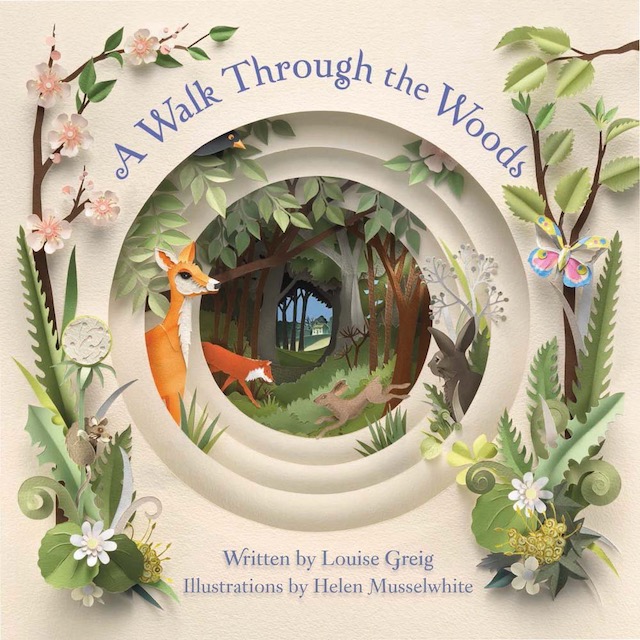
A Walk Through the Woods is similar to Worm Weather in that it also is very lyrical in the way that it’s written and it takes you through, step by step, a walk through the woods on a spring day. But this book is definitely more appropriate for children older than 5 because the vocabulary and structure of the text is much more sophisticated. It consists of lyrical sentences and couplets, and it also varies between observation and description, and the rhythm changes as the book progresses, so it isn’t exactly as easy or straightforward a read as Worm Weather. In fact, I wouldn’t actually assign A Walk Through the Woods a top end of the age range because I think adults can really appreciate the language and style just as much as children. BUT, that being said, I don’t think it’s one of those books that turns you off because it is trying too hard to be highbrow or to wow you with its profundity. Children can be resistant when it comes to reading poetry because often it isn’t done very well for them. A lot of the time it’s too sickly sweet or too nostalgic or too contrived or too self-conscious. And I mean, I hate that kind of poetry, too, so who can blame them? But I don’t think this is one of those books. Instead, I think it really is a contemplative and evocative recounting of what it could really be like to walk through the woods in spring if you were able to just be a silent, unobtrusive observer. It has some sentimental notes to it, but I don’t think it’s overdone.
But even if poetry isn’t your thing or your child’s thing at all, that’s okay because I think the real strength of the book and what really makes it excellent and why I’m recommending it to you are the illustrations. Helen Musselwhite makes these super-intricate, multi-layered scenes using colored and painted paper that she cuts by hand and then photographs. The result is just… I think the best word for it is actually “exquisite” even though I’m trying not to use that word! It’s stunning and a totally immersive experience because the technique Musselwhite uses to layer the cuts on the double spreads makes it seem as if you are peering deeper into the forest as well as looking back over your shoulder. The way she is able to create depth and shadows and texture is just remarkable and there are so many tiny details for your child to discover on each page, like a little mouse peeking out of the underbrush or the layered ripples in the pond where the deer is drinking. This book is just a gorgeous piece of art and I can see why it’s marketed as a keepsake. Which, incidentally, is another reason why I think it’s better for older children or for you to read with your child because the only downside to the delicate paper cuts is that it’s definitely more fragile than a regular picture book. But, in any case, I think this book is an excellent, painless way to incorporate some poetry into your read-aloud sessions with your child AND you both will really marvel at the intricacy of the illustrations.
Additionally, both Worm Weather and A Walk Through the Woods are great books to read in conjunction with going outside on a nature walk, or going puddle jumping, or even just a walk around your neighborhood. If you have older children, you can ask them to do some free association writing in the style of A Walk Through the Woods as a supplemental activity or even ask them to try their hand at making a paper cut scene. There are tutorials for this kind of art on YouTube that you and your child can watch to figure out how to cut and layer the pieces. If you have younger children, you can use Worm Weather to inspire your child to go on a puddle jumping expedition or a worm rescue mission after it rains. You can talk about what you need to wear to go out in the rain; you can bring along a magnifying glass to look at the worms close up (we have a cute and very durable one by Melissa and Doug); you can bring along binoculars to search the sky for rainbows, and so forth—anything to make it a bit of an adventure. And if you don’t have binoculars, another activity you can do with your child is make some out of a paper towel roll cut in half, some tape, a hole punch, and some string. You can have your child decorate the binoculars with paint or stickers or whatever else you might have in your house and put them to use by going on a walk.
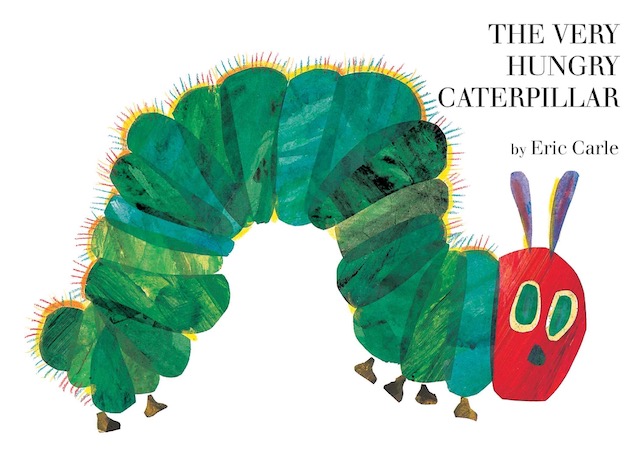
Okay, so before I end this episode, I have 2 more bonus books specifically for toddlers and young preschoolers that I just want to mention really briefly because it’s likely that you already have one or the other or even both of these two books in your possession right now, so you wouldn’t need to order them or try to find an online version or anything. And those two books are The Very Hungry Caterpillar by Eric Carle and Little Blue Truck’s Springtime by Jill McElmurry and Alice Shertle. The Very Hungry Caterpillar is probably THE classic picture book for spring, but also just in general it’s a classic so many people have it in their child’s book collection. I think pretty much every person of my generation learned that caterpillars turn into butterflies because of this book. And it definitely deserves to be a classic. It has everything little kids want: drama, humor, interesting facts about the natural world, really unique and eye-catching illustrations, a sensory experience with the holes the caterpillar chews, even delicious food! The only thing I think is wrong with it is that now we all think a butterfly comes out of a cocoon, when it really comes out of a chrysalis. But even that can be an interesting thing that you and your child talk about. What’s also nice is that there is a short film version of The Very Hungry Caterpillar that I think is on Netflix, but is also available on YouTube, so you could read the book and then your child could also watch the little movie and you’d get a 15 minute break without feeling guilty about screen time. Which, really, you shouldn’t feel guilty about screen time, but I’m Greek so I feel guilty about, you know, breathing, sleeping, everything so it’s nice when I get a reprieve. And there are SO many Very Hungry Caterpillar activities and crafts that you can do if you look on pinterest or just do a google search, so that’s another great thing about this book.
LITTLE BLUE TRUCK’S SPRINGTIME
And then Alice Shertle’s Little Blue Truck’s Springtime is also a book that I think a lot of families with young children might already have because of the popularity and pervasiveness of the Little Blue Truck for this generation of kids. And, by the way, I think that its popularity is very well-deserved because the original Little Blue Truck, as I mentioned in Episode 1, is one of our absolute favorite board books. If you haven’t already and you want to hear more about the original Little Blue Truck book, you can go back and listen to Episode 1. AND if you’d like my list of the top 25 best board books for toddlers, I’ll leave a link in the shownotes for that, too.
Now back to Little Blue Truck’s Springtime. Just a disclaimer, this is not my favorite of the companion books to the original Little Blue Truck book. If I’m honest, I think I personally prefer Little Blue Truck Leads the Way and then maybe Little Blue Truck’s Halloween. HOWEVER, James was and Luke currently is obsessed with Little Blue Truck and their love isn’t discriminating. They both really enjoy all of the companion books and usually request that we read them one after the other, so if your child is a Little Blue Truck fan, it’s more than likely that your child will also love this book—and that you might already own it. If that’s the case, this is obviously the perfect time to bring it into your rotation of read aloud books. And even though it isn’t my favorite, it’s still a great springtime book, especially for toddlers but also for older children who still have a fondness for these books. I love Jill McElmurry’s illustrations; in this book in particular they are just so bright and cheery and whimsical. I love that all the toads have flower crowns like they’re in some sort of toad Mardi Gras parade.
And I like that you can, again, use this book in multiple ways. You can use it as a way to do some animal recognition with your child and teach her animal sounds as well as to teach her the names of baby animals; you can use it to practice counting; you can use it as a seek and find book, and so on. Plus, it’s a lift the flap book which is always a hit with toddlers. And it has very sturdy flaps, which I always really appreciate. Our copy has survived two very active toddlers and a lot of random incidents. Like, just this week, for example, we have been trying to do a family walk every day that the weather permits just to, you know, get out of the house and get a change of scenery, and we have this thing called a veer cruiser that’s part stroller/part wagon that we put the boys in to take them along. It’s really great because you can push it or pull it and it goes on all sorts of terrain, but anyway, my littlest guy Luke loves it because it has a cupholder tray where he likes to put books and toys to play with while we walk. This week he really wanted to take Little Blue Truck’s Springtime along with us and prop it up on the little cupholder tray to “read” it as we went along. I think he wanted to bring it because we’ve read it almost every day this week and we live near a farm where there are baby lambs and baby goats and a couple of foals and then there is a dairy farm up the road, so I don’t know, I think he feels like he’s living out toad’s journey in the little blue truck or something. Kids are quirky. Anyway, he of course dropped it over the side and we rolled the veer, with both of the kids in it, right over the open book with one of the flaps sticking out and it came through without any rips and even without so much as a skid mark. So, yes, that turned out to be a long story, but, in any case, this book is very durable and as a mom, I appreciate that.
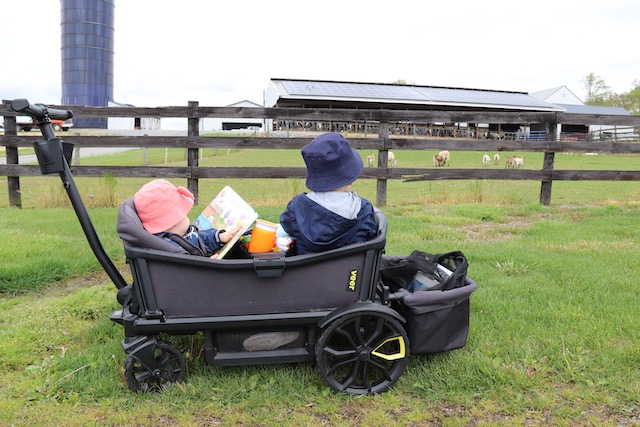
Finally, to get back on track as I end this episode, I think all of the books that I talked about today are really excellent choices to read with your children this spring in particular because even though we often think of reading as an indoor activity, books like these can give us the inspiration and impetus to get outside and interact with nature. Being outside, in the natural world, can positively impact a child’s physical and mental health, which they all really need right now, as well as positively impact their development. Playing outside has a lot less structure than playing indoors, so that supports a child’s creativity as well as enhances their cognitive abilities and problem-solving skills. There are also studies that show that not only does going outside reduce anxiety and stress in children, but it also improves their academic performance. So now more than ever while we’re all stuck at home, worrying about the world, but also trying to keep our children’s brains stimulated and their emotions balanced, it’s really important that we encourage and help our children to get outside and reap those benefits and these springtime books can really give us the inspiration to do so.
So that’s it for this episode of the Exquisitely Ever After podcast! Thank you all so much for listening—I really appreciate it! Please visit the show notes at, ExquisitelyEverAfter.com/episode2 for a complete list of the books and tools and toys that were mentioned today and you can download the free PDF of the weather images if you’d like to do a weather tracking activity with your children this spring. And I will also post some pictures of the spring activities and crafts that my little boys and I did this week in the shownotes and also on Instagram at Exquisitely Ever After if you need help visualizing them. If you do any of them with your children this spring, please tag me so that I can see! And if you liked this episode or this podcast in general, please do subscribe, it’s totally, totally free and by subscribing you ensure that you don’t miss any new episodes. AND, if you have a minute in between homeschooling or zoom conferences or FaceTiming the grandparents, please leave a review on iTunes. For a new show like mine, it helps so much.
I’d also love to hear what books you and your families are reading this spring! Send me an email at christina@exquisitelyeverafter.com or dm me on Instagram at exquisitelyeverafter or leave me a comment on the blog post for this episode, exquisitelyeverafter.com/episode2 with any of your springtime book favorites. Once again, as always, I really appreciate that you took time to listen to me talk about reading to children today! Thank you so much again and thank you to the doctors, nurses, healthcare workers, the people in reception at our doctors’ offices and hospitals, sanitation workers, grocery store clerks, delivery drivers, factory workers making health products and food—we are all so grateful for you and all that you do. Take care everyone, keep safe, and keep reading!
Pin This Episode for Later
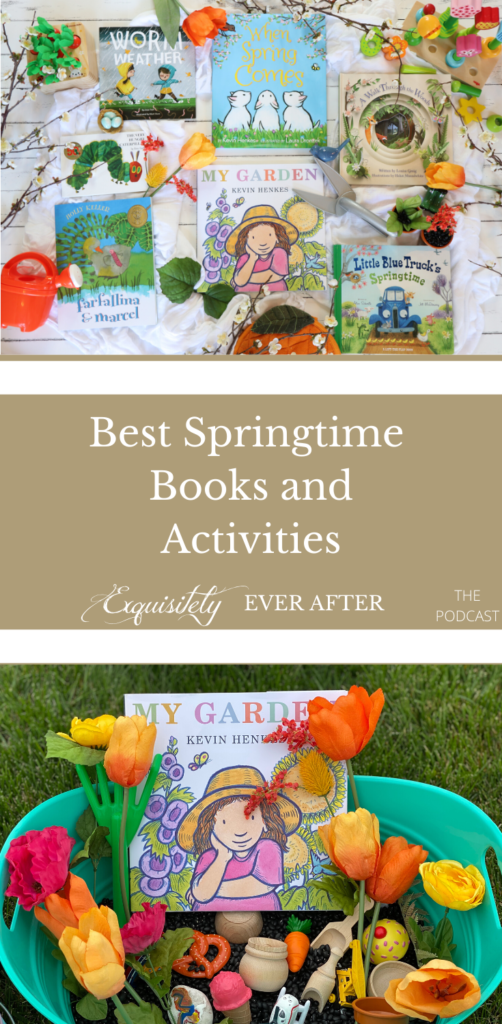
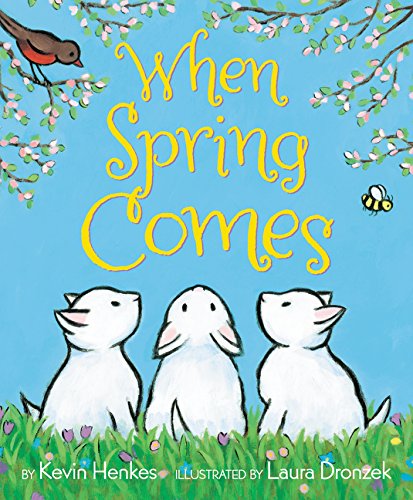
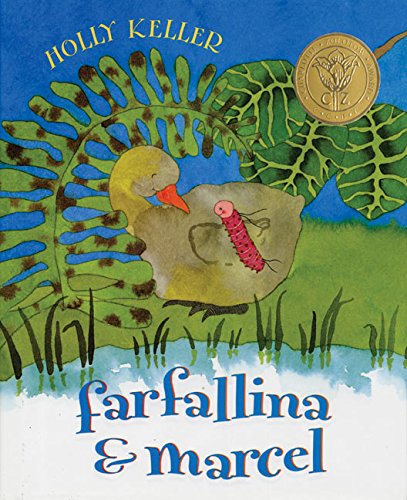
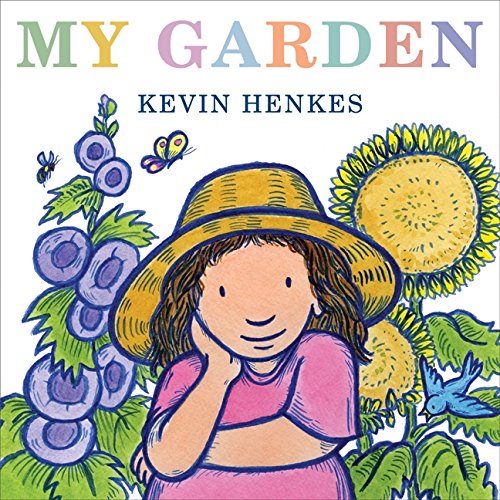
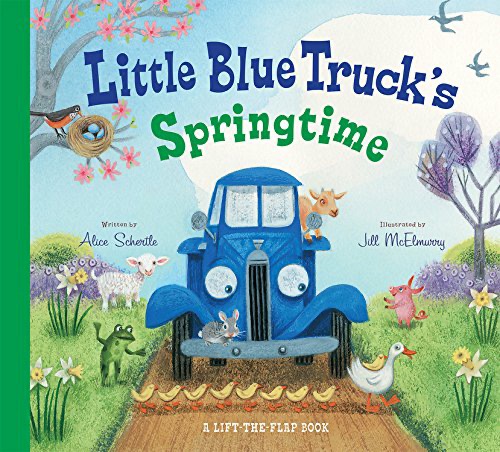


[…] a contemporary lift-the-flap that my children love and that I talked about in detail in Episode 2. But even if the book doesn’t have an extra sensory element like a flap or holes or […]